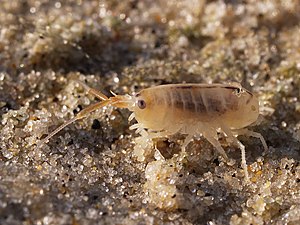Beach flea
| Beach flea | ||||||||||||
|---|---|---|---|---|---|---|---|---|---|---|---|---|

Beach flea ( Talitrus saltator ) |
||||||||||||
| Systematics | ||||||||||||
|
||||||||||||
| Scientific name | ||||||||||||
| Talitrus saltator | ||||||||||||
| ( Montagu , 1808) |
The beach flea ( Talitrus saltator ), also known as the common beach flea , sand or beach hopper , is a species from the order of the amphipods , which is often found above along the high water line of sandy beaches in the Atlantic , the North and Baltic Seas and the Mediterranean . The representatives of the Talitridae family are the only land-dwelling amphipods . Contrary to the German name, these crustaceans are historically far removed from the fleas belonging to the insects and not closely related to them .
features
The animals reach a length of 15 (16) millimeters and have a strongly flattened body on the sides. They are milky white to light gray in color, with brownish or blue spots. Like all amphipods, they do not have a back armor ( carapace ) so that the individual breast segments are visible. The large, round complex eyes are black and clearly recognizable. While the first (upper) pair of antennas is very short, the second - especially in males - appears very long and ends in a row of small, rough-toothed limbs. The peraeon (main part of the thorax ) has seven pairs of sternum bones (most of which are walking legs), the turned abdomen ( pleon ) has three pairs of swimming legs and three pairs of transformed ankle legs. The extremities of the second pair of breastbones, the so-called gnathopods , have a claw-like end member.
Occurrence, way of life
The beach flea colonizes the upper flushing fringes (the supralitoral ) of the sandy beaches of the Atlantic and its European tributaries as well as the Mediterranean. During the day, the animals stay buried in the damp sand or hidden under flotsam ( seaweed , wood, etc.) in order to be active in large flocks at night and to search for food. They feed on stranded algae and other plant and animal components. With jerky blows of the abdomen or the three pairs of jump legs attached there, beach fleas can make long sets of up to 30 centimeters away. On firm sand, they almost only move forward by jumping. For one-time wintering and for spring tides, they dig several decimeters deep into the sand. In order to find the shortest route into the sea and back again, the animals should orientate themselves on the position of the sun or moon.
In addition to this species, there are other "beach fleas" of different genera in the same habitat. The best known species besides this species is Orchestia gammarella . The genus Talitrus is distributed mainly circumtropically with ten species , Talitrus saltator in the warm-temperate north-east Atlantic region. Beach fleas are an important food source for some beach-dwelling bird species.
swell
literature
- Heiko Bellmann with Gerhard Maier: Spiders, crabs, millipedes - European arthropods (without insects). Steinbach's nature guide. Mosaik-Verlag, Munich 1991, ISBN 3-570-06450-6
- Andrew Campbell: The Kosmos Beach Guide. Franckh-Kosmos, Stuttgart 1977, ISBN 3-440-04355-X
Web links
- ITIS Report online query "Beach flea". Integrated Taxonomy Information System, accessed February 27, 2010 .


